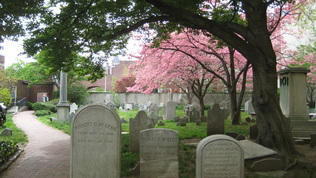
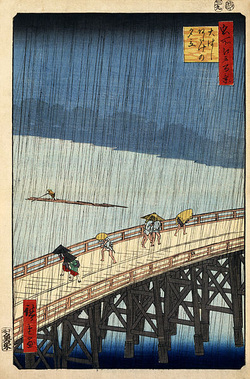
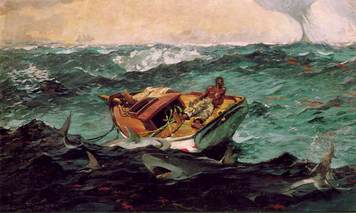
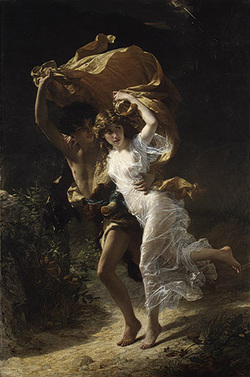
| artsmarttalk.com |
|
 St. Peter's Churchyard, Center City Philadelphia A hurricane is a strange event. In my Philadelphia neighborhood, not so far from the coast, full of majestic trees in parks and old churchyards, we worried about branches falling in the heavy winds. Instead we got tons of rain with very little wind and no damage to speak of. We were lucky - not so much those in other places, especially inland areas of Vermont and New York State, where they must have thought a hurricane was not their concern. So, with those unfortunate places and people in mind, here are a few examples of Stormy Art from other times and places.  Oshashi Bridge & Atake in a Sudden Shower Nobody ever did rain and wind like Hiroshige and Hokusai, the grand Ukiyo-e masters of late 19th century Japan. One glance at Hiroshige's Oshashi Bridge & Atake in a Sudden Shower (1856) and you feel the rain pelting down your neck and soaking your clothes. Hokusai's marvelous Ejiri in Suruga Province (1830-1833) with his signature view of Mt. Fuji makes you grab for your hat. This windy image has had a rash of imitators lately, most notably Jeff Wall with his A Sudden Gust of Wind (after Hokusai) (1993) - detail here - and also Carrie Marill's A Sudden Gust of Wind (After Hokusai) 2009. (see gallery below)  Winslow Homer The Gulf Stream 1899 And then there's Winslow Homer, the taciturn New Englander whose watercolors are the stuff of magic. He turned his attention to stormy weather more than once, with some of the greatest examples coming from his trips to Florida, Cuba, and the Bahamas in 1884-1885. One of the most poignant of his narratives in paint is The Gulf Stream (1899) in which a lonely sailor sits helpless, his mast broken and his boat adrift, as the sharks gather in the waves around him. For him the storms - all storms - are nearly over, whether that cloud in the distance is coming or going.  The Storm 1880 And lastly, a bit of Romantic sentiment to point up the truth and strength of the others. Pierre-Auguste Cot did The Storm in 1880 with his paintbox full of allegory and pictorial illusion. His reference is not the driving force of the wind or the very real need to take shelter, but the charm of flirtation on a summer afternoon, based on the Greeks and their lighter stories. The past week of earthquakes and hurricanes will also be the stuff of stories, some charming, some not. Good luck to all those who are still struggling with the aftermath of Irene.
1 Comment
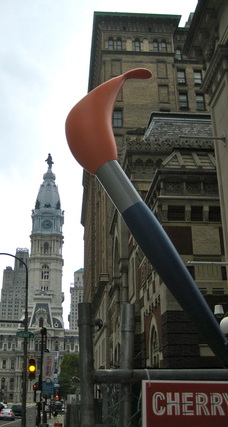 Paint Torch with the Philadelphia City Hall Philadelphia, already rich in public art, has a new guy in town. Claes Oldenburg was here Saturday, installing his giant, goofy 'Paint Torch' at the Pennsylvania Academy of Fine Arts. Goofy, for Oldenburg, is a term of endearment. His witty, double-take inducing sculptures stop even the Philistines in their tracks - a giant flashlight amid the neon of Las Vegas, a fountain of flying orange peels in Miami, huge, helter-skelter bowling pins in the Netherlands, an ice cream cone teetering over a shopping street in Cologne, Germany. And many more. Claes Oldenburg studied in Chicago then made his name as a Pop Artist in New York in the 60's, with works like 'Soft Toilet' (1966) now in the Whitney Museum of Art, where I once read a note from him saying something about wanting people to see the objects for their forms and shapes, not for their function - that in time the function might disappear, but the object would still be beautiful. The idea is already well along, as with his wonderful 'Typewriter Eraser' (1999 - National Gallery of Art) - try explaining that one to a 15 year old. 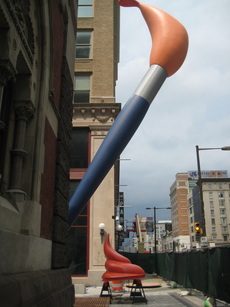 Paint Torch - 51 feet high with a 6 foot drip 'Paint Torch' is the 4th Oldenburg in Philadelphia - it joins 'Giant Three-Way Plug (1970) at the Art Museum, 'Split Button' (1981) on the Penn Campus, and the iconic 'Clothespin' (1976) on Market Street by City Hall. 'Paint Torch', 51 feet high, with a blue handle and a full brush or orange paint in mid-swirl, includes a six-foot glop of a drip for the pavement. Oldenburg sat watching the installation Saturday from a bench, directing it to the exact angle he wanted, the one he thought looked most welcoming. It does have an arc, as you can see by the pictures, that appears to wave you into the plaza of the Pennsylvania Academy of Arts - and over from the huge spanking new convention center across the street. 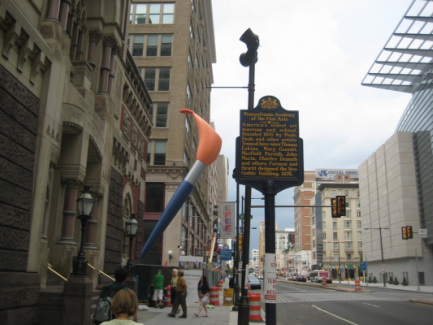 Paint Torch at PAFA, the oldest museum and school in the US (1805) Part of the wit of the work, as with most of Oldenburg's public art, is the context, in this case the also witty, arty, extraordinary Victorian extravaganza that houses the oldest art museum and school in the US. (founded in 1805 by painter Charles Wilson Peale and sculptor William Rush.) The building, which was dedicated in 1876, is a masterpiece by the great Frank Furness, a Civil War hero who designed more than 600 buildings, too many of which have been destroyed though there are other splendid examples in and around Philadelphia. He was a major influence on later architects of note, including Louis Sullivan and Frank Lloyd Wright. A great deal of brush-swishing has gone on in that building - Oldenburg's 'Paint Torch' is a very contemporary tribute to past glories and to the future brilliance being honed in the PAFA school. One of the most famous names associated with PAFA is that of Thomas Eakins, the great American Realist painter, who began his career as a brilliant and iconoclastic teacher in the Furness building the year it opened. 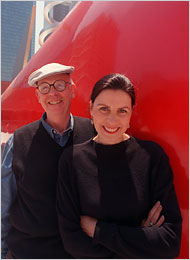 On a sadder note, 'Paint Torch' is Oldenburg's first work installed after the 2009 death of his beloved wife and working partner, Coosje van Bruggen, who was essential to his life and work from the 1970's on. See a slide show of 'Paint Torch' being installed (New York Times) http://www.nytimes.com/slideshow/2011/08/23/arts/design/Arts-Brielfy--Oldenburg.html The website of Claes Oldenburg and Coosje van Bruggen with a full list of work and installations http://www.oldenburgvanbruggen.com/ 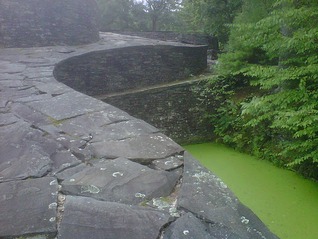 Who can pinpoint where creativity begins or say where it will take the person who allows it into their life? I don't agree with the cliche that 'everyone is an artist' - the talent, perseverance, etc., etc., required to earn that title by a serious committed life in art is not so easy to come by - but every person does contain the capacity to be creative. I would even say that every person has the potential to make, build, or institute something of lasting creative significance for themselves and others. (See note at the end about an opportunity to develop your creativity through a wonderful program.) All this came to mind when I was once again up in the Hudson Valley for great music (see last week's post - this time it was the SummerScape Festival at Bard College) - and once again, happily, had an unexpected, fascinating encounter. 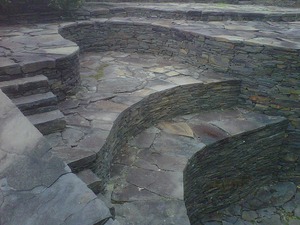 Playing hooky one morning from Sibelius, my husband and I followed a back road in the town of Saugerties, lured deep into the woods by a chance notice. At the end of that road we discovered Opus 40, an astonishing site that was added to the Registry of Historic Places in 2001. We pulled into the parking lot and found, first, a ramshackle barn containing a museum of tools, then a split log family house, and finally, to our amazement, a construction that took my breath away as the view opened up and I realized the scope of it. Against a backdrop of Catskill mountains and cloudy sky, I witnessed a creative obsession winding, climbing, and twisting across the remains of an old bluestone quarry, built entirely of that blue-grey material like some ancient Pre-Columbian city. 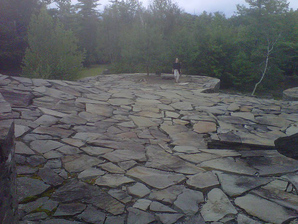 The man behind Opus 40 was Harvey Fite (1903-1976), a sculptor and professor at Bard College, who had started out to be a lawyer, tried the seminary, had a short acting career, and then discovered his true passion for making - making things - three-dimensional, hard, material, things. Opus 40 isn't just a work of art, an installation - it was and is Harvey Fite's life. He wasn't part of any movement or group, though he's now considered a pioneer of the Environmental Movement of the 70's, and the most important show of his work was almost certainly the posthumous tribute in 1977 at the Hirshhorn Museum. If Andy Goldsworthy wasn't inspired by him, he should have been.  Part of Fite's inspiration came from his encounter with, in fact, the Pre-Columbian Mayans, after he helped with restoration work in Honduras. When he came home he used the same, mortar free techniques in building Opus 40. Near the entrance it mounts to a high viewpoint crowned by a standing stone - the Monolith - then broad sloping paths lead you away, past deep crevices, around smooth, tailored walls, as neat and tidy as cross-stitch work, past the crumbling heart of the old quarry, onto grass paths that take you further into the woods, to more walls, more stone, more paths. 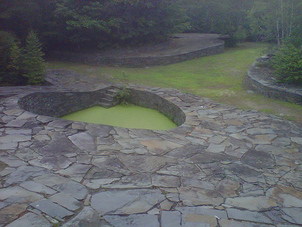 The ground turns a bit muddy, signifying the presence of water, and as you circle back you find pools, bright green with algae, fitted snugly into curving walls, and another of clear water with the rusted remains of a well-worn diving board signifying a reward at the end of what must have been many long hot hard-working days. At one moment it all seems organic, as if this complex puzzle of stone, land, and water had just willed itself into being, but the next moment one stands in awe of one man's patience for detail in the service of his broad vision. http://www.opus40.org/fite.htm 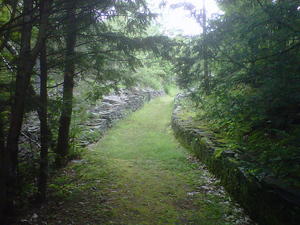 It's not likely that your search for creativity will lead you to build an Opus 40, but if you would like to free yourself to develop your creative side, strengthen your confidence in your artistic capacity, and get more pleasure out of the right side of your brain, think about signing up for the program: The Artist's Way (based on the ground-breaking book by Julia Cameron) with Stephanie Costello, an excellent clinical social worker in Philadelphia who has had phenomenal success helping people find their own rich sources for creative and artistic satisfaction. The next program begins September 14 (both evening and daytime sessions) - you can see details on Stephanie's website http://www.stephaniecostello.com/for_groups.html#artists Stephanie is warm, compassionate, and passionate about helping people to be happier and more creative - this is a great opportunity! (Note: I've never been a fan, personally, of the Julia Cameron approach. What prompted this rare endorsement was hearing Stephanie speak with great conviction of how successful it has been over the years, and how she particularly puts it to use to help people.) Thanks to Rick Fitzgerald for the pictures! 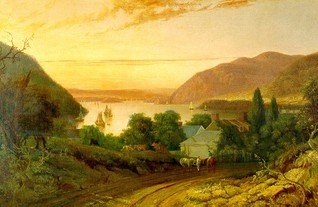 Seth Eastman - View of the Hudson River 1834 The Hudson Valley, up where it meets the broad shoulders of New York's Adirondack Mountains, is as calm and golden on a summer weekend as ever in a 19th century Hudson River School painting. In between lakes and mountain shadows old family motels with nostalgic clusters of cabins line the roads, little Norman Rockwell vignettes of 1950's togetherness that are a bit sad to see, but mostly still open for business. I was up that way there for the timeless pleasure of great music - in this case the Philadelphia Orchestra at the Saratoga Performing Arts Center - and by the luckiest of chances also met a most interesting contemporary artist. 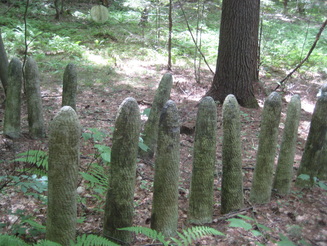 Bruno LaVerdiere - Standing 'Tomb' forms Bruno LaVerdiere is deeply rooted in the Adirondacks - the great and mighty Hudson runs near his home, though at that point it's a surprisingly tame and burbling stream - but he got there by way of a childhood in Maine, a Benedictine monastery in the Pacific Northwest, a few years in New York City, and an impressive career teaching and working in the US and Europe. Over the course of 30 years he turned a summer cabin into a comfortable compound of art and life, where the view from all corners is trees, trees, trees - until you swing round to a clear miles-long view of a broad blue sky and a favorite mountain. Before the house the first glimpse of Bruno's work came bit by bit along his private dirt road, standing ceramic forms spotted amid the ferns and wild greenery. Tomb forms, he says they are, a series inspired by a local graveyard after he moved up into this quiet corner from New York City. 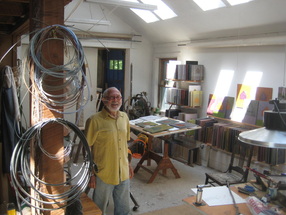 Bruno in his studio The history of a rich artistic life continues in his studio, a sprawling custom built structure with plenty of room for new and old work, and all the cool tools a gadget-loving artist would ever need. A huge car kiln sits behind the studio like a dormant Fire God, resting patiently while these days Bruno is busy with painting. He says he has discovered color after a long love affair with black and white, and he appears to be having a great time. 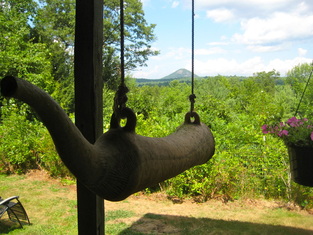 The view and the Horn He's one of those artists who makes it all work, makes it significant no matter how casual the effort - the standing ceramic forms, slashed and pummeled into iconic, compelling shapes, the huge inky abstract drawings, the series of simple, single cats, the latest colorful encaustic explorations founded on a geometric house diagram, and the huge ceramic horn hanging on the porch for all to try their luck. Thank you, Bruno, for homemade yogurt with homegrown blueberries, for a refuge from bats, and especially for the art, the laughter, and all the great stories. |
Share ArtSmartTalk
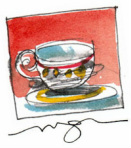
MacGregor-Art.com Cards and art gifts with a Fine Sense of Fun Also at http://www.etsy.com/shop/MacGregorArt ArtSmart Consulting
|
| Blog: |
| ArtSmartTalk |
Topics: |
| Art History, Design, Art |
All
19th C Art4a3f8ec7db
20th C59300e1f29
African Art
Almutanabbi Streetbb1c3786e2
American Art
Ann Hamilton
Apple
Apple Computers
Arabic Poetry
Architecture
Art
Art And Nature
Art And Technology
Art As Collective Memory
Art Auctions
Art Books
Art Forgery
Art Galleries
Art History
Art In Gardens
Art Installation
Art Installations
Art Licensing
Art Of Spain
Art Prints
Art Technology
Baghdad Books
Barnes Collection
Biennial
Book Project
Books
Brooklyn Museum
California Design
Chelsea Galleries
Chess
Color
Constable
Contemporary Architecture
Contemporary Art
Contemporary Design
Design
Detroit Institute Of Arts
Drawing
E H Shepard
El Anatsui
Etching
European Art
Expressionism
Fabric Design
Flags
Folk Art
French Art
French History
French Portraits
Galleries
George Bellows
Goya
Goya Black Paintings
Goya Portrait
Hand-made Books
Historical Art
Hokusai
Ho Tanner
Illustration
Installation Art
Iraq
Jean Clouet
Lacma
Lewis Chessmen
London
Los Angeles
Mac Computers
Mary Cassatt
Matisse
Met Museum
Metropolitan Museum
Metropolitan Museum Of Art
Modern Art
Modern British Painting
Moma
Moma Ps1
Moons
Museums
Napoleon
National Gallery
Nature
New Architecture
New Art
New Design
New Goya Painting
New York
New York Art
Norse Art
Novels About Art
Old City Philadelphia
Online Art Sites
Outdoor Art
Outsider Art
Painting
Paris
Pat Steir
Performance Art
Philadelphia
Philadelphia Art
Philadelphia Museum
Photography
Plein Air
Portraits
Product Design
Red
Religious Art
Rembrandt
Rome
Rothko
Royal Portraits
Sarah Sze
Scottish Art
Self-portraits
Significance Of Art
Sketching
Southern California
Soutine
Spanish Art
Spanish History
Steve Jobs
Technology
Thanksgiving
The Importance Of Art
Turner
Van Gogh
Velasquez
Venice Biennale
Whitney Museum
Words And Art
Young Artists
August 2013
May 2013
February 2013
January 2013
December 2012
November 2012
October 2012
September 2012
August 2012
July 2012
June 2012
May 2012
April 2012
March 2012
February 2012
January 2012
December 2011
November 2011
October 2011
September 2011
August 2011
July 2011